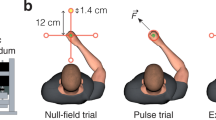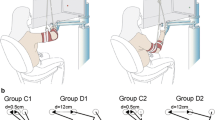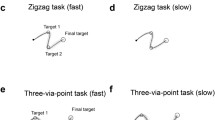Abstract
When humans perform goal-directed arm movements under the influence of an external damping force, they learn to adapt to these external dynamics. After removal of the external force field, they reveal kinematic aftereffects that are indicative of a neural controller that still compensates the no longer existing force. Such behavior suggests that the adult human nervous system uses a neural representation of inverse arm dynamics to control upper-extremity motion. Central to the notion of an inverse dynamic model (IDM) is that learning generalizes. Consequently, aftereffects should be observable even in untrained workspace regions. Adults have shown such behavior, but the ontogenetic development of this process remains unclear. This study examines the adaptive behavior of children and investigates whether learning a force field in one hemifield of the right arm workspace has an effect on force adaptation in the other hemifield. Thirty children (aged 6–10 years) and ten adults performed 30° elbow flexion movements under two conditions of external damping (negative and null). We found that learning to compensate an external damping force transferred to the opposite hemifield, which indicates that a model of the limb dynamics rather than an association of visited space and experienced force was acquired. Aftereffects were more pronounced in the younger children and readaptation to a null-force condition was prolonged. This finding is consistent with the view that IDMs in children are imprecise neural representations of the actual arm dynamics. It indicates that the acquisition of IDMs is a developmental achievement and that the human motor system is inherently flexible enough to adapt to any novel force within the limits of the organism’s biomechanics.
Similar content being viewed by others
Author information
Authors and Affiliations
Corresponding author
Rights and permissions
About this article
Cite this article
Jansen-Osmann, P., Richter, S., Konczak, J. et al. Force adaptation transfers to untrained workspace regions in children. Exp Brain Res 143, 212–220 (2002). https://doi.org/10.1007/s00221-001-0982-8
Received:
Accepted:
Published:
Issue Date:
DOI: https://doi.org/10.1007/s00221-001-0982-8




